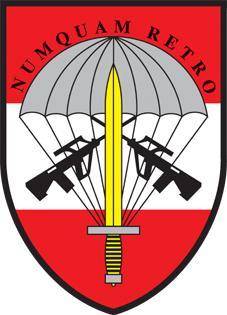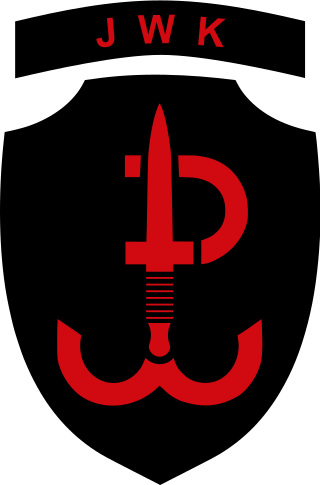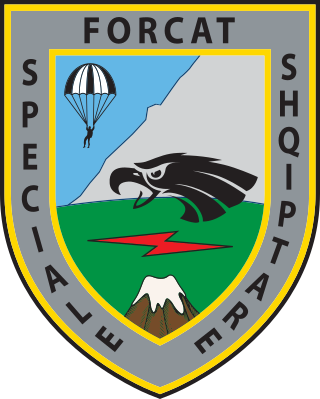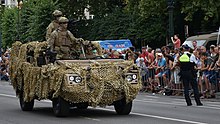
The 1st Commando Regiment is an Australian Army Reserve special forces unit, part of Special Operations Command with an integrated structure of regular (full-time) soldiers and reserve (part-time) soldiers, which together with the full-time Australian Army 2nd Commando Regiment, provides the commando capability to Special Operations Command. Raised in 1955 it is the oldest unit within Special Operations Command and in 2008 deployed to Afghanistan to become the first Australian Army Reserve force element on combat operations since World War II. The regiment is the Command's capability lead for special warfare.

The Kommando Spezialkräfte (KSK) is the special forces military unit and a large brigade-level unit of the German Armed Forces (Bundeswehr) for special operations and commando warfare, reconnaissance, counterterrorism, combat search and rescue as well as military advisor. The KSK reports to the Rapid Forces Division (DSK) and is stationed in the Graf Zeppelin barracks in Calw, Baden-Württemberg.

The Jagdkommando is the Austrian Armed Forces' special forces unit. The unit is based at Wiener Neustadt and is known to have a manpower of 400 operators.

The Jednostka Wojskowa Komandosów, commonly called JWK and formerly known as 1 Pułk Specjalny Komandosów, is one of six special forces units currently operating within Poland's Centrum Operacji Specjalnych - Dowództwo Komponentu Wojsk Specjalnych. JWK was formed in 1961 and is the oldest still active Polish special operations unit. The unit is located in Lubliniec, Poland. The regiment has carried out the majority of special operations that resulted in the gathering of the actual Polish Intelligence. In the early years of the global war on terrorism, The regiment carried out special operations alongside US Navy SEALs from the Naval Special Warfare Development Group also known as SEAL Team Six.

The All Arms Commando Course (AACC) lasts for 13 weeks and is run by the Royal Marines at the Commando Training Centre Royal Marines (CTCRM), Lympstone. Members from any of the United Kingdom's Regular Armed Forces and overseas exchange personnel can attend to serve with 3 Commando Brigade. On completion of the course the successful candidate earns the right to wear the green beret, and to wear the "Commando Dagger" on their uniform. The Royal Marines expect that nearly half of the volunteers will drop out or be dismissed before completing the AACC. The primary aim of the course is to give service personnel the core military skills necessary for Extremely and Very High readiness Commando and Littoral Strike operations.

The Unidad de Operaciones Especiales was the elite special operations force of the Spanish Navy and marines from 1967 to 2009. In June 2009, the unit was absorbed into the newly formed Special Naval Warfare Force, which inherited the reputation and which continues the record of the UOE. The UOE was formerly garrisoned in the Tercio de Armada in San Fernando, Cádiz and operated under the direct control of the Admiralty and Special Naval Warfare Command. It was thought to comprise approximately 100 men organized into three Operational Teams as well as command and support personnel. The unit has long been one of Europe's most respected special forces.

Para (Special Forces), also known as Para Commandos or Para (SF) Commandos, is a group of special forces battalions of the Parachute Regiment in the Indian Army. These units specialize in various roles including counter-terrorism, hostage rescue, unconventional warfare, special reconnaissance, counter-insurgency and direct action.

The Special Actions Detachment or DAE is the tier one special force maritime unit of the Portuguese Navy. It is part of the Portuguese Marine Corps. Raised in 1985, the DAE is one of the smallest special forces units within the Portuguese Armed Forces. It is responsible for conducting air-sea rescue, amphibious reconnaissance, amphibious warfare, black operation, bomb disposal, CBRN defense, coastal raiding, counterterrorism, direct action, executive protection, hostage rescue, irregular warfare, ISTAR, long-range penetration, JTAC, manhunt high-value target, maritime sabotage, mountain rescue, naval boarding, operation behind high risk enemy lines, special operations, special reconnaissance, tracking targets, underwater demolition, unconventional warfare, other missions in support of Portuguese and NATO armed forces. DAE's mission and training are similar to American special forces and it often trains with them.

The 1st Marine Infantry Parachute Regiment or 1er RPIMa is a unit of the French Army Special Forces Command, therefore part of the Special Operations Command.
The Underwater Offence, or SAT, is the special operations forces unit of the Turkish Navy, and the first and only navy commando unit of the navy, consisting of highly skilled soldiers selected from among the officers and petty officers of the Turkish Navy. They are affiliated with the Naval Operation Directorate. During wartime, these units are responsible for carrying out stealthy attacks, sabotage, and raids on enemy strategic facilities including those located under water, over water, on land, or in the air. They also target floating platforms. The SAT participates in coastal reconnaissance tasked with obtaining information on coastal areas before deploying forces and maintaining control over foreign ports and underwater areas.

The Regiment Special Force (RSF) is a Sri Lanka Air Forces elite special force unit, which is part of the SLAF Regiment. It was raised in 2006.The RSF Wing is an independent formation of the SLAF and commanded by a Commanding Officer who is responsible to the Commander of the Air Force through Director Ground Operations for the efficient and effective function.

The Marine Commandos are an elite unit of the Lebanese Army. They are part of the Lebanese Special Operations Command. Established with assistance from the United States Navy SEALs and the British Royal Marines, they are tasked with conducting a variety of missions, particularly in a maritime environment, which include: sabotage, raids, beach landings and maritime counter-terrorism. The Marine Commandos were established in 1997, then got their administrative independence in July 2001.

The Commando Regiment is an elite light infantry and is considered the first special forces regiment in the Lebanese Armed Forces. The regiment, which was founded in 1966, is also a member of the Lebanese Special Operations Command and is the largest of the Lebanese special units. An individual member of the regiment is a maghwār

The 2nd Commando Regiment is a special forces unit of the Australian Army and is part of Special Operations Command. The regiment was established on 19 June 2009 when the 4th Battalion RAR (Commando) was renamed. It is based at Holsworthy, New South Wales. The 2nd Commando Regiment trains and has served with coalition special forces units, and is highly regarded by these units. The regiment has been involved in operations in East Timor, Iraq and Afghanistan, where it was used in a direct action warfighting role. It has also been involved in domestic security operations including the 2006 Commonwealth Games and the 2014 G20 Leaders Summit. The regiment is the Command's capability lead for strike and recovery.

The Special Task and Rescue Team, abbreviated as STAR, serves as the command for elite maritime special operations and underwater divers within the Malaysia Coast Guard. It was established as a rapid reaction force for emergencies within the maritime zone of Malaysia.

The Special Forces Qualification Course (SFQC) or, informally, the Q Course is the initial formal training program for entry into the United States Army Special Forces. Phase I of the Q Course is Special Forces Assessment and Selection (SFAS). A candidate who is selected at the conclusion of SFAS will enable a candidate to continue to the next of the four phases. If a candidate successfully completes all phases they will graduate as a Special Forces qualified soldier and then, generally, be assigned to a 12-men Operational Detachment "A" (ODA), commonly known as an "A team." The length of the Q Course changes depending on the applicant's primary job field within Special Forces and their assigned foreign language capability but will usually last between 56 and 95 weeks.

The Special Operations Regiment, commonly known as B.O.S is the main special forces unit of the Albanian Armed Forces. It is the most elite unit of the Albanian Army. The unit is tasked with special operations in wartime, and primarily with counter-terrorism in peacetime.
Royal Marines recruit training is the longest basic modern infantry training programme of any Commonwealth, or North Atlantic Treaty Organization (NATO) combat troops. The Royal Marines are the only part of the British Armed Forces where officers and other ranks are trained at the same location, the Commando Training Centre Royal Marines (CTCRM) at Lympstone, Devon. Much of the basic training is carried out on the rugged terrain of Dartmoor and Woodbury Common with a significant proportion taking place at night.
The Namibian Special Forces is a special operations command of the Namibian Defence Force responsible for special forces and special operations capable units. The command consists of Army commandos, Army Airborne paratroopers and the Marine Corps amphibious special operations unit. The Army commandos specialize in airborne and land borne insertion while the Marine Corps amphibious special operations unit specialize in small-unit maritime operations that originate from a river, ocean, swamp and delta. The army units receive training assistance from former South African Special Forces (Recces) and the marine corps from the Brazilian Marine Corps. The units regularly participate in Southern African Development Community (SADC) special forces exercises.
The 104th Operational Maneuvers Regiment is a special forces regiment of the Algerian Land Forces, and is also a parachute regiment.




















